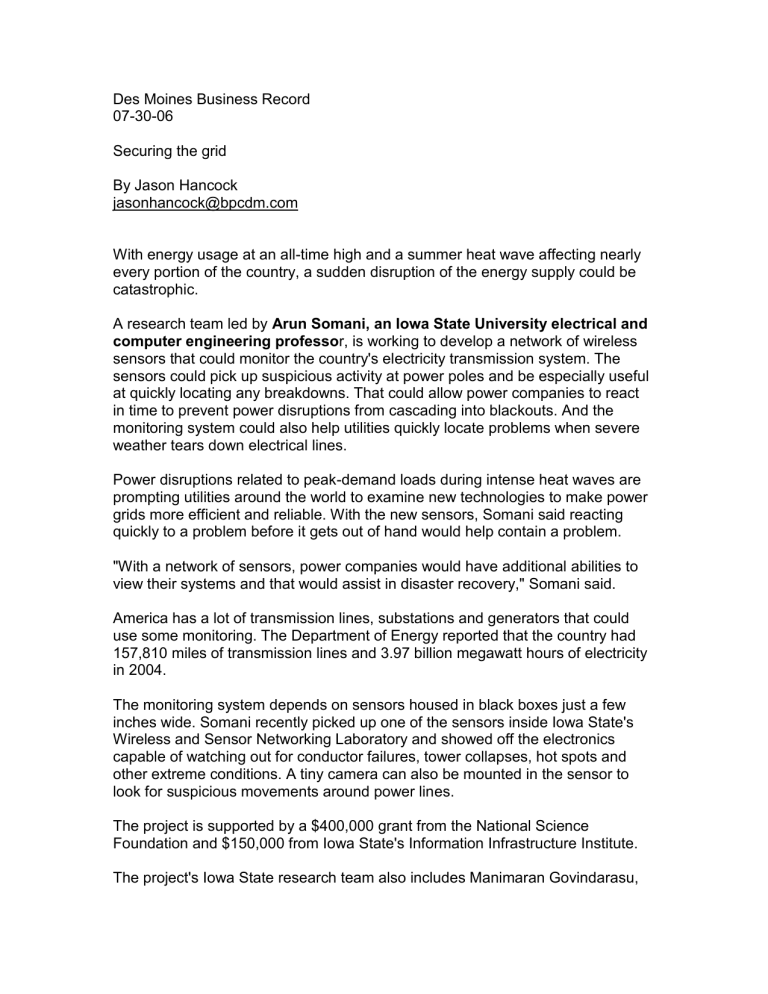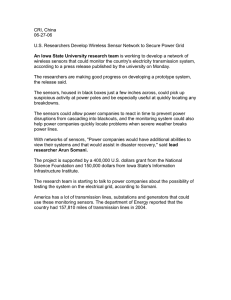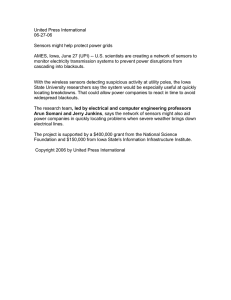Des Moines Business Record 07-30-06 Securing the grid

Des Moines Business Record
07-30-06
Securing the grid
By Jason Hancock jasonhancock@bpcdm.com
With energy usage at an all-time high and a summer heat wave affecting nearly every portion of the country, a sudden disruption of the energy supply could be catastrophic.
A research team led by Arun Somani, an Iowa State University electrical and computer engineering professo r, is working to develop a network of wireless sensors that could monitor the country's electricity transmission system. The sensors could pick up suspicious activity at power poles and be especially useful at quickly locating any breakdowns. That could allow power companies to react in time to prevent power disruptions from cascading into blackouts. And the monitoring system could also help utilities quickly locate problems when severe weather tears down electrical lines.
Power disruptions related to peak-demand loads during intense heat waves are prompting utilities around the world to examine new technologies to make power grids more efficient and reliable. With the new sensors, Somani said reacting quickly to a problem before it gets out of hand would help contain a problem.
"With a network of sensors, power companies would have additional abilities to view their systems and that would assist in disaster recovery," Somani said.
America has a lot of transmission lines, substations and generators that could use some monitoring. The Department of Energy reported that the country had
157,810 miles of transmission lines and 3.97 billion megawatt hours of electricity in 2004.
The monitoring system depends on sensors housed in black boxes just a few inches wide. Somani recently picked up one of the sensors inside Iowa State's
Wireless and Sensor Networking Laboratory and showed off the electronics capable of watching out for conductor failures, tower collapses, hot spots and other extreme conditions. A tiny camera can also be mounted in the sensor to look for suspicious movements around power lines.
The project is supported by a $400,000 grant from the National Science
Foundation and $150,000 from Iowa State's Information Infrastructure Institute.
The project's Iowa State research team also includes Manimaran Govindarasu,
an associate professor of electrical and computer engineering; Murti Salapaka, an associate professor of electrical and computer engineering; and Zhengdao
Wang, an assistant professor of electrical and computer engineering. Former
Iowa State faculty member Vijay Vittal, now a professor of electrical engineering at Arizona State University, is also working on the project. Each of the researchers brings different areas of expertise to the project.
And it's not an easy project, Somani said.
The researchers need to design a system that stands up to inclement weather and also sensors that can accurately monitor the power grid's electrical and mechanical characteristics. They need to find a way to monitor the areas around electrical equipment for suspicious activity.
They need to develop wireless communication networks so the sensors can send comprehensive data from far-flung areas to control centers. They need to design a diagnosis algorithm to accurately determine fault conditions and predict faults.
They need to design a decision algorithm to reconfigure the power network to prevent or alleviate cascading failures. And they need to find ways to get electricity to the sensors because the electrical lines they're monitoring carry the wrong kind of power.
Somani said the researchers are making good progress on developing a prototype system. He said the research team is also starting to talk to power companies about the possibility of testing the system on the electrical grid. And, he said, it's an important project for national security.
"With the increasing threat of terrorism around the world, more attention is being paid to the security of the transmission infrastructure," a summary of the project said. "Experiences in countries like Colombia, which has faced as many as 200 terrorist attacks on its transmission infrastructure per year, demonstrate the vulnerability of the power system to these kinds of events."





